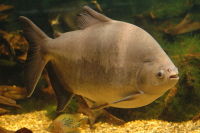Black Pacu (Colossoma macropomum)
From The Aquarium Wiki
Black Pacu
Colossoma macropomum
1893 Litres (500 US G.)
108-110 cm (42.5-43.3")
Freshwater
5.0 - 7.8
22 -28 °C (71.6-82.4°F)
10-20 °d
1:1 M:F
12-25 years
Family
Characidae
Contents
Additional names
- Black Pacu, Black-Finned Pacu, Giant Pacu, Tambaqui, Gamitana
Additional scientific names
- Piaractus macropomus, Colossoma nigripinnis, Colossoma oculus, Myletes nigripinnis, Myletes oculus, Piaractus nigripinnis
Origin[edit]
- South America: They are found throughout much of the Amazon and Orinoco River basins in South America. This species is not listed on the IUCN Red List. Other common names it is know by are Pacu, Black-finned Pacu, Black-finned Colossoma, Giant Pacu, Cachama and Gamitana. They have been introduced in New Guinea as a food source in 1994 to the Sepik River, and in 1997 to the Ramu River. They have also been introduced in multiple countries in South America including Bolivia, Peru, Colombia, Brazil, and Venezuela; in Central America including Cuba, Dominican Republic, Honduras, Jamaica, and Panama; and the United States of North America. They are solitary, and as juveniles they live in the black waters of flood plains, feeding on insects, snails, and decaying plant matter. Adults move to the flooded forest areas for the initial few months of the flood season, and feed on fruits and grains.
Sexing[edit]
- The dorsal fin on the male is more pointed than the female and the anal fin on the male has a toothed edge.
Tank compatibility[edit]
- An exceptionally large fish that will co-exist with other peaceful tank busters and large peaceful fish such as Silver Dollars and Tinfoil Barbs.
Diet[edit]
- The Black Pacus are omnivores and in the wild they will consume fruits, grains, insects, snails, detritus and plant matter. In the aquarium they will readily eat most anything and can be offered frozen foods as well as a pellet diet. Feed it a primarily vegetarian diet with foods such as vegetarian pellets and blanched vegetables.
Feeding regime[edit]
- Once or twice a day.
Environment specifics[edit]
- Needs a very large tank, over 3785 Litres (1000 US G.) once mature and around a 101.6cm (40") long. Open swimming space and excellent filtration is a must. Black Pacu are large fish and should only be cared for in commercial aquariums or by the most experienced fish keepers with the space and financial ability to care for these giants. They are actually very hardy and easy to care for. The are not very picky about aquarium water conditions, and are used in aquaculture because they can live in mineral poor waters and are very disease resistant. The size alone limits who will able to keep one as they would need an aquarium upwards of a 1000 gallons.
Behaviour[edit]
- Peaceful fish which will generally not bother other tank mates.
Identification[edit]
- Very large and rounded fish, eyes and mouth appearing small for the rest of the body once mature. Has some visible teeth despite its vegetarian diet. Has iridescent scales which are dark silver grey in colour with hues of red and blue, fins are dark grey. The Black Pacu can get up to get up to 42.5 inches (106 cm) in length and weigh up to 66 pounds (30 kg). The body of the adult Pacu is very deep and laterally compressed with a slight arch to the back. They have a life span of 20 to 25 years in the aquarium. Its fins are black. It is often confused with the Piranha when small. As juveniles they are almost identical in appearance, but as the Black Pacu matures it becomes more rounded and wider than the Piranha. The easiest way to tell the difference when they are young is that the jaw of the Piranha will jut out more than that of a Pacu.
Pictures[edit]
External links[edit]
- Fishbase (Mirrors:
 )
)
